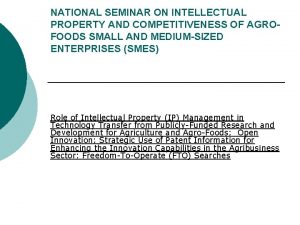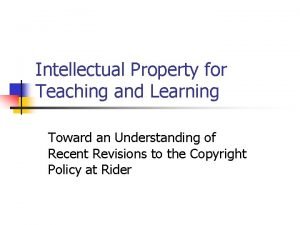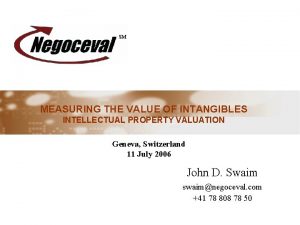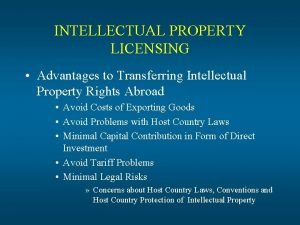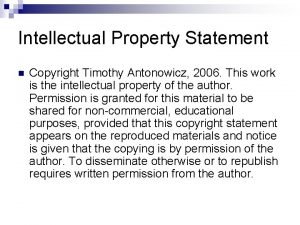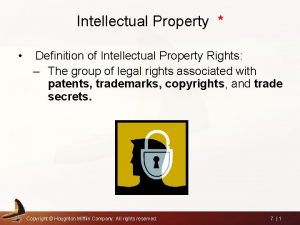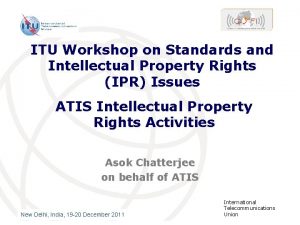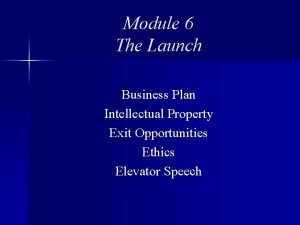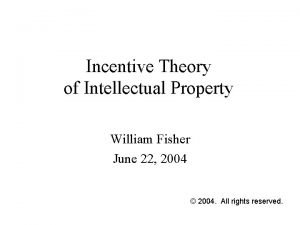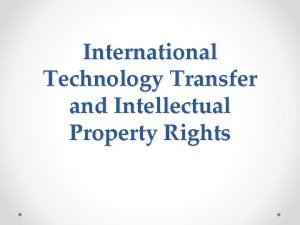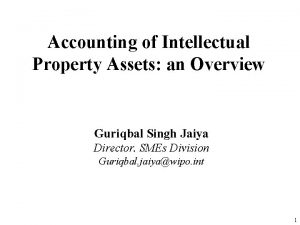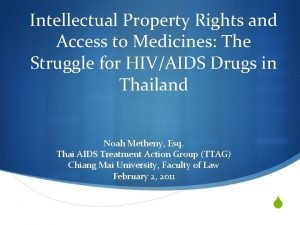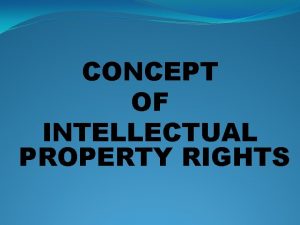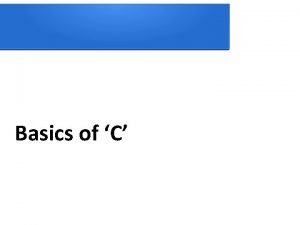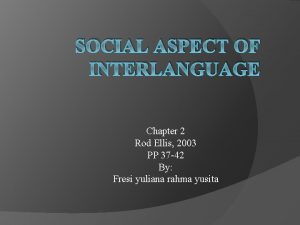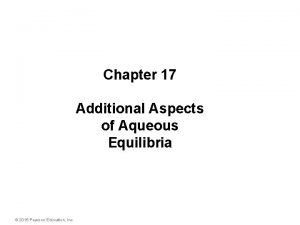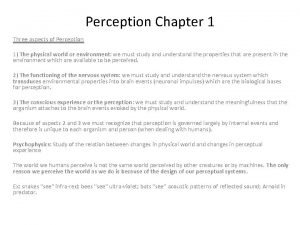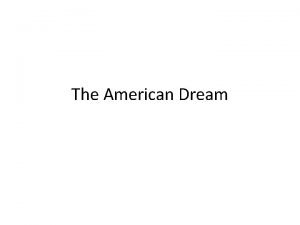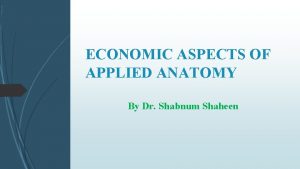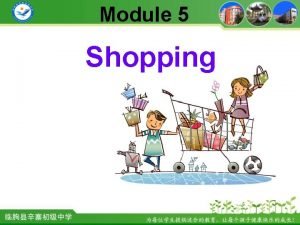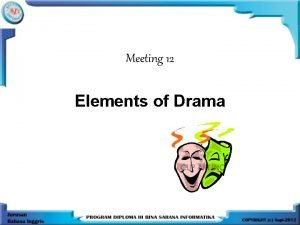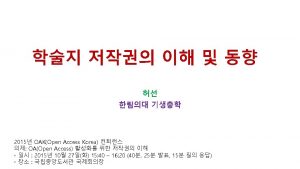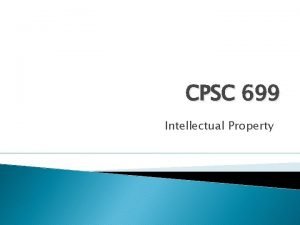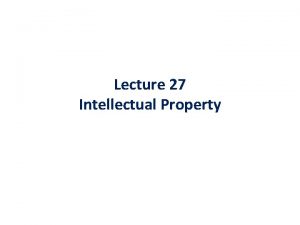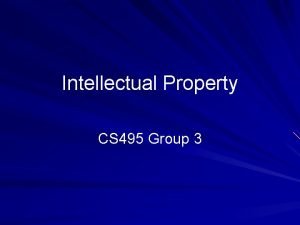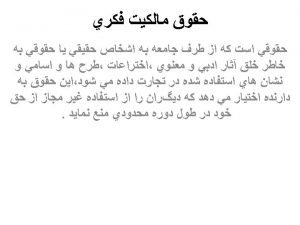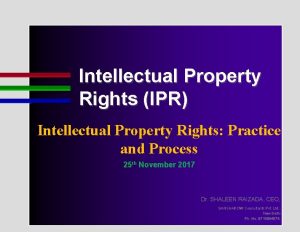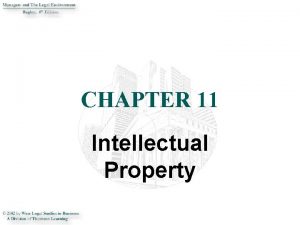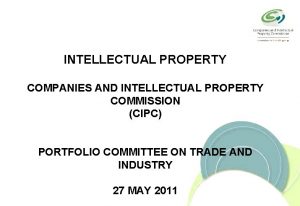THE AGREEMENT ON TRADERELATED ASPECTS OF INTELLECTUAL PROPERTY




















![Basic Principles Article 4 provides for most-favored-nation treatment: “[w]ith regard to the protection of Basic Principles Article 4 provides for most-favored-nation treatment: “[w]ith regard to the protection of](https://slidetodoc.com/presentation_image/763d4214329a85541fa8e35a8555ed4c/image-21.jpg)




































































- Slides: 89

THE AGREEMENT ON TRADERELATED ASPECTS OF INTELLECTUAL PROPERTY RIGHTS (TRIPS) Standard WTO Presentation, adapted for use at the Santa Clara University School of Law Summer Program July, 2017 by Edward Kwakwa, Senior Director, WIPO 1

What are Intellectual Property Rights? • Intangible Property/Private Rights • They are rights given to persons over the creation of their minds. They usually give creator/inventor an exclusive right over the use of his/her creations/inventions for a certain period of time. • Broadly divided into two categories: copyright and related rights, and industrial property. • The TRIPS Agreement covers seven types of IPRs 2

Types of Intellectual Property 1. 2. 3. 4. 5. Copyright and Related Rights Trademarks Geographical Indications Industrial Designs Lay-out Designs (Topographies) of Integrated Circuits 6. Patents (+ sui generis protection) 7. Protection of Undisclosed Information 3

WHY PROTECT INTELLECTUAL PROPERTY RIGHTS? • Equity/Human Rights rationale • Public Interest/Utilitarian rationale – Incentive function • encourage and reward creative work: individual authors, cultural industries • Technological innovation: means to finance research and development – Fair Competition • Distinctive signs stimulate and ensure fair competition among producers and traders 4

Why Protect IP? (ctnued) • Consumer Protection – Distinctive signs enable informed choices – Product Safety • Transfer of Technology – FDI, Joint Ventures & Licensing • IP Holders’ Perspective • Importers’ (other users’) perspective • Recognized as an objective under Art. 7 • Proactive measures for the benefit of LDCs under Art. 66. 2 • Weight of empirical evidence points towards positive correlation 5

WHY AN AGREEMENT ON TRIPS? • Growing trade in counterfeit (trademark) goods and lack of common rules to deal with the problem • Perceived flaws of WIPO Conventions: – Absence of detailed rules on national enforcement – Absence of binding and effective dispute settlement mechanism • Computerisation and digital technology 6

Why Agmt. on TRIPs (ctnued) • Devpd & Devping accepted because: – Uruguay Round Trade-Offs – Balance and flexibility in TRIPS – Multilateral rule of law in IP (& trade) area – Consistent with move to more open and market-based economic policies – Alternative would have meant negotiating bilateral (or plurilateral) agmts. 7

Balance: exclusive rts subject to limitations • Balance between competing authors/producers • Balance and flexibility in TRIPS – Long term interest in promoting creativity and short term social interest in maximizing access – Interests of generators and users of IP Members have clarified balance and, in one respect, amplified flexibilities in area of public 8 health

Pre - TRIPS Agreement WIPO-Administered Agreements • Berne Convention for the Protection of Literary and Artistic Works • Paris Convention for the Protection of Industrial Property • Several Others – about 18 • Also, numerous other regional and bilateral IP protection agreements 9

THE DEVELOPMENT OF MULTILATERAL DISCIPLINES • Proposals that action should be taken in the GATT to control trade in counterfeit and pirated products were made by developed countries during the Tokyo Round. During the Uruguay Round, the developed countries proposed that the negotiations should not only cover trade in counterfeit and pirated goods, but also aim at developing minimum standards of protection for adoption by member countries. 10

THE DEVELOPMENT OF MULTILATERAL DISCIPLINES • There were several reasons behind the proposal of developed countries: – the loss of competitiveness in traditional sectors such as steel, textiles and clothing and manufactures and the changing economic activity in most developed countries. – the gradual removal of restrictions on foreign investment by a large number of developing countries; conclusion of joint ventures etc – technological advances in reproduction and imitation of products 11

THE DEVELOPMENT OF MULTILATERAL DISCIPLINES • Response of Developing countries: – Lukewarm response. Entertained thought that stronger protection of IP rights would lead to an increase in the prices of drugs and agricultural chemicals. Debate as to whether IP could be used as a tool for economic and social development. • THE AIDS crisis in sub-Saharan Africa highlights this problem. Should IP rights be strengthened at the expense of other policy objectives including health policy of a country? • Would stronger protection of IP encourage FDI? • Developing countries were quite worried about these problems, but nevertheless agreed to negotiations on 12 IP. Quid pro quo?

THE DEVELOPMENT OF MULTILATERAL DISCIPLINES • It was against these concerns that the TRIPS Agreement was negotiated. • Negotiations launched in Punta del Este (Uruguay) September 1986 • Negotiations concluded towards the end of 1993 • Text adopted at Marrakech (Morocco) - April 1994 13

"Incorporation" technique • • The TRIPS Agreement builds on the main international conventions on IP rights by incorporating (by reference) most of their provisions. To ensure coherence To avoid re-opening of texts To negotiate the + elements To have a short but comprehensive text Paris IPIC Berne Rome 14

STRUCTURE AND APPROACH OF THE TRIPS AGREEMENT – Basic principles and general obligations – Minimum standards of protection covering (i) the subject-matter to be protected, (ii) rights conferred; and (iii) term of protection – Domestic procedures and remedies for the enforcement of IPRs – Transitional provisions 15

Preamble 16

STRUCTURE AND APPROACH OF THE TRIPS AGREEMENT • Minimal requirements/Minimum standards: Members can provide higher protection • “Shall provisions” and “may provisions” • TRIPS to be read in conjunction with certain Treaties • Each section dealing with a particular type of IP right: – Definition (if possible) – Conditions for protection – Exclusive rights – Exceptions and limitations to exclusive rights – Minimum duration of protection 17

Nature and Scope of Obligations • Article 1: – Members MAY provide greater protection – Members free to determine appropriate method of implementation – “Intellectual Property” refers to types of IP referred to in the Agreement 18

Beneficiaries • Article 1: – Treatment to be applied to nationals of other Members • Refer to relevant Conventions • Industrial Property • Copyright • Related rights 19

Basic Principles The cornerstone of the TRIPS Agreement is the nondiscrimination principle. • Article 3 provides for national treatment: – “[e]ach Member shall accord to the nationals of other Members treatment no less favourable than that it accords to its own nationals …” 20
![Basic Principles Article 4 provides for mostfavorednation treatment with regard to the protection of Basic Principles Article 4 provides for most-favored-nation treatment: “[w]ith regard to the protection of](https://slidetodoc.com/presentation_image/763d4214329a85541fa8e35a8555ed4c/image-21.jpg)
Basic Principles Article 4 provides for most-favored-nation treatment: “[w]ith regard to the protection of intellectual property, any advantage, favour, privilege or immunity granted by a Member to the nationals of any other country shall be accorded immediately and unconditionally to the nationals of all other Members…”. – Exemptions: • Treaties on judicial assistance or law enforcement of a general nature • Berne/Rome Convention advantages granted on basis of treatment granted in another country • “Related rights” not provided for under Agreement • Rights under international agreements entered 21 into before TRIPS Agreement came into force

Basic Principles • Article 5: Multilateral Agreements on Acquisition or Maintenance of Protection – Arts. 3 and 4 do NOT apply to: • Exceptions provided for in multilateral WIPO agreements • Relating to acquisition or maintenance of IPRS 22

Objectives: Preamble • Main Elements: – Reduction of distortions and impediments to trade – Promotion of effective and adequate IPR protection – Enforcement should not lead to barriers to trade – Cater to the special needs of Developing and Least. Developed countries. 23

Objectives : Art. 7 • PROTECTION and ENFORCEMENT of IPRs to contribute to: – Promotion of technological innovation – Transfer and dissemination of technology • To mutual advantage of PRODUCERS and USERS of technological knowledge • In manner conducive to SOCIAL and ECONOMIC welfare • To BALANCE rights and obligations 24

Objectives : Art. 8 • Members MAY adopt measures necessary to: – Protect public health and nutrition – Promote the public interest in sectors of vital importance to socio-economic and technological development – Prevent abuse of IPRs or practices which • Unreasonably restrain trade OR • Adversely affect international transfer of technology 25

Copyright: Substantive Principles • Berne Convention (1971) • Three basic principles – National treatment – Automatic protection – Independence of protection • Works protected • Minimum standards of protection • Permissible exceptions • Term of protection • Appendix 26

Copyright: Berne Convention • The Berne Convention for the Protection of Literary and Artistic Works was concluded in 1886, but has been revised several times. 174 States party. • Article 9(1) of the TRIPS Agreement incorporates Articles 1 -21 of the Berne Convention (Paris Act 1971) and the Appendix thereto by reference. • Exception is Article 6 bis dealing with moral rights on which there was no consensus among WTO Members. 27

Copyright: NT, Automatic & Independence of Protection – National Treatment: No discrimination between nationals and foreigners – Automatic protection: Protection should not be made subject to any formality of registration, deposit or the like. – Independence of Protection: Enjoyment and exercise of rights granted is independent of the existence of protection in the country of origin 28

Coypright: Subject Matter • What IS protected? – Art. 9(2) TRIPS and Article 2 Berne Convention • All forms of “expressions ” – • Every production in the literary, scientific and artistic domain, whatever the mode or form of its expression • Article 10 TRIPS • Computer programs – Source or object code • Compilations of data – Machine-readable or other form which by reason of selection or arrangement – Involve intellectual creation 29

Coypright: Subject Matter • What IS NOT protected? – Article 9(2) TRIPS • Ideas, procedures, methods of operation or mathematical concepts - 30

Coypright: Conditions for Protection Fundamental Criterion: Originality 31

Coypright: Exclusive Rights • Berne Convention: – Right of translation – Right of reproduction – Right of public performance, including communication to public – Right of broadcasting, including communication to public – Right of adaptation, arrangement and other alteration 32

Coypright: Exceptions • Berne Convention – Reproduction in special cases – Quotations and use of works by way of illustration for teaching purposes – Reproduction of newspapers to report current events – Ephemeral recordings – TRIPS Agreement, Art. 13: – Limitations/Exceptions to exclusive rights confined to – Special cases which • Do not conflict with normal exploitation • Do not unreasonably prejudice legitimate interests 33 of right holder

Coypright: Term of Protection • Berne Convention, Art. 7 – Life of author + 50 years after death • TRIPS Agreement, Art. 12: – If term of protection calculated on basis OTHER than life of natural person • >= 50 years from end of calendar year of authorised publication • if no authorised publication within 50 years from making of work, 50 years from end of calendar year of making 34

Trademarks: Paris Convention • Refer to Paris Convention (1967) including Articles – – 4 : Priority 5. C: Use 6 bis: Well-known Marks 6 quinquies: Registration & eligibility for protection in countries other than country of origin – 6 sexies: Protection of service marks – 7: Nature of goods not obstacle to registration – 7 bis: Registration of collective marks 35

Trademarks: Subject Matter Article 15 : SHALL obligation – Definition: • Sign or combination of signs • Capable of distinguishing the goods or services of one undertaking from those of other undertakings • Shall be capable of constituting a TM • Such signs shall be eligible for registration as TMs • Factors relevant to criterion of "distinctiveness" 36

TMs (ctnued) • Art. 15(2) – other grounds • Distinctiveness is the most important factor regarding TM registrability, but Art. 15(2) of TRIPs, Members not prevented from denying registrations of TMs on other grounds (eg against morality/public order (my own example), provided they do not derogate from provisions of Paris Convention. 37

Trademarks: Subject Matter • Illustrative list of signs capable of constituting a TM – Inclusive List: • Personal names e. g. • Letters e. g. • Numerals • Figurative elements • Combinations of colours 38

Trademarks: Registration • Additional Requirements for Registration – Art. 15. 1 : MAY provision • Where signs are not inherently capable of such distinction, registrability may be made dependent on distinctiveness acquired through use • Members may require, as a condition of registration, that signs be visually perceptible. – Art. 15. 3: MAY provision • Where registrability is made dependent on use, actual use of a trademark shall not be a condition for filing an application for registration • Note that Service marks must be protected in same way as 39 marks distinguishing goods

Trademarks (ctnued) • Two egs from Member’s legislation: • “Any word, name, symbol, or device, or any combination thereof (Lanham Act, as amended, U. S. A. ) • “Any visually perceptive distinctive sign, when not prohibited under law, is susceptible of registration as a mark. ” (Industrial Property Law n. 9. 279 of 1996, Brazil) 40

Trademarks: Exclusive Rights • Article 16. 1: What can a TM owner do? – Prevent 3 rd parties • Using • In course of trade • Identical/similar signs • For goods/services • Identical/similar to registered trademark • Likelihood of confusion – Likelihood of confusion PRESUMED in case of • identical sign for idential goods/services 41

Trademarks: Exceptions • Article 17 – Limited exceptions to exclusive rights such as: • Fair use of descriptive terms – Take account of legitimate interests of: • Owner • 3 rd Parties 42

Trademarks: Cancellation • Article 19 – If use is required to maintain registration, cancellation cannot take place before three years of uninterrupted non-use – Circumstances beyond control of owner recognised as legitimate, e. g. import or other government restrictions – Art 20: Use of the trademark shall not be unjustifiably encumbered by special requirements, such as use with another trademark, in special form, or in a manner detrimental to its capability of being distinguished from other goods or services 43

Trademarks: Term of Protection • Article 18 – Initial registration and each renewal: • >= 7 years – Renewable indefinitely 44

Geographical Indications: Subject Matter • Article 22. 1 – Definition: • Indication • Identify a good as originating in – Member's territory – Region or locality in that territory • Quality, reputation or other characteristic of good • Essentially attributable to its geographical origin Gruyère 45

GIs • Relatively wide definition • Reflected in great majority of WTO Members’ laws • Only goods 46

Geographical Indications: Exclusive Rights • Article 22. 2(a): Applies to ALL goods and is a SHALL provision – – – Prevent use of any means In designation or presentation of a good Indicates/suggests Good in question originates in a geographical area Other than true place of origin Manner which misleads the public as to geographical origin of the good 47

Geographical Indications: Exclusive Rights • Article 22. 2(b): Applies to ALL goods and is a SHALL provision – Prevent any use – Constitutes an “act of unfair competition” under Article 10 bis Paris Convention (1967): • “Act of competition contrary to honest practices in industrial or commercial matters” 48

Geographical Indications: Wines and Spirits • Article 23: – Additional Protection – ONLY for wines and spirits 49

Geographical Indications: Exceptions • Article 24: – – 24. 4: Continuous use 24. 5: Prior trademark rights 24. 6: Generic terms 24. 8: Use of person’s name or name of person’s predecessor in business – 24. 9: No/cessation of protection in country of origin OR fallen into disuse 50

Geographical Indications: Multilateral Register. Wines • Article 23. 3 & 4: – Facilitate protection of GIs for wines – Art. 23. 4: Establishment of a multilateral system of notification and registration of • Geographical Indications for wines • Eligible for protection in participating Members 51

Geographical Indications (concluding remarks) • TRIPS provisions on GIs: delicate compromise, heavily negotiated. – High economic/commercial stakes but also highly emotional social/cultural aspects – Lack of harmonization at nat’l & int’l levels – Linkages • Within GI sector (for the GI issues) • Outside GI sector but within TRIPS context (eg TRIPS-CBD) • With other WTO discussions or negotiations, in particular Agriculture 52

Industrial Designs: Subject Matter • Article 25. 1: – NO definition BUT • Members SHALL provide protection: – “Independently created industrial designs” • Members MAY provide that NO protection: – Designs dictated essentially by technical OR functional considerations 53

Industrial Designs: Conditions for Protection • Article 25. 1: – Independently Created – New or Original – Significantly differ from known designs or combinations of known designs 54

Industrial Designs: Textiles • Article 25. 2: – Requirements for protecting textile designs • Shall not unreasonably impair opportunity to seek and obtain protection – Industrial design law OR copyright law 55

Industrial Designs: Exclusive Rights • Article 26. 1: – Right to prevent 3 rd parties from • Making • Selling • Importing – Articles embodying protected design – Copy/substantially a copy of protected design – For commercial purposes 56

Industrial Designs: Exceptions • Article 26. 2 – Limited exceptions to exclusive rights – Do not unreasonably conflict with the normal exploitation – Do not unreasonably prejudice legitimate interests of • Owner • Taking into account legitimate interests of third parties 57

Industrial Designs: Term of Protection • Article 26. 3 – at least 10 years 58

Integrated Circuits: Subject Matter • Article 35: – Layout-designs (topographies) of integrated circuits – In accordance with • Articles 2 - 7 (except Article 6(3)), Article 12 and Article 16(3) of IPIC • AND to comply with additional provisions in the TRIPS Agreement 59

Integrated Circuits: Term of Protection • Article 38 – at least 10 years from • Date of filing of an application for registration OR • First commercial exploitation 60

Patents • Article 27. 1: – Members must make “patents“ available – Patents must be availabe and patent rights enjoyable without discrimination as to: • place of invention • field of technology • whether products are imported or locally produced 61

Patents: Definition • Article 27 defines “patentable subject-matter“ as: – Any inventions – Whether products or processes – In all fields of technology 62

Patents: Conditions for Patentability • Article 27. 1 specifies the conditions for patentability: – New (i. e. novelty) – Involve an inventive step (non-obvious) – Capable of industrial application (useful) 63

Patents: Exceptions (1) • Article 27. 2: Ordre Public or Morality – Inventions may be excluded from patentability if: • prevention of commercial exploitation of invention is necessary within Member´s territory • to protect ordre public or morality • Including to: – protect human, animal or plant life or health – avoid serious prejudice to the environment 64

Patents: Exceptions • Debate spawned by Article 27. 3(b): – Biodiversity – Traditional knowledge – Farmers´ rights • Recent progress in biotechnology and genetic engineering has raised many issues including whether compensation should be provided to traditional communities when inventions draw on knowledge existing in these communities. For centuries, parts of plants (roots, barks, leaves, flowers and fruits) have been used in some traditional communities to treat certain sicknesses 65 such as malaria and arthritis, etc.

Relevance of Doha Ministerial Declaration • Para 12 mandates examination of: – Relationship between the TRIPS Agreement and the CBD – Traditional knowledge – Other new developments raised under TRIPS Article 71. 1 • Para 12 also states that: "In undertaking this work, the TRIPS Council shall be guided by the objectives and principles set out in Articles 7 and 8 of the TRIPS Agreement and shall take fully into account 66 the development dimension. "

Relevance of Doha Ministerial Declaration • Para 4 of Doha Ministerial Declaration on the TRIPS Agreement and Public Health: "We agree that the TRIPS Agreement does not and should not prevent Members from taking measures to protect public health. Accordingly, while reiterating our commitment to the TRIPS Agreement, we affirm that the Agreement can and should be interpreted and implemented in a manner supportive of WTO Members' right to protect public health and, 67 in particular, to promote access to medicines for all. "

Relevance of Doha Ministerial Declaration • A Proposal received from a group of developing countries stresses the need to modify the TRIPS Agmt, as it contains no provisions to prevent biopiracy (illegal access and use) or ensure prior informed consent and the fair and equitable sharing of benefits. 68

Relevance of Doha Ministerial Declaration • Proposal that applicants for patents should be able to disclose source of origin of the biological resource & associated traditional knowledge; and evidence of prior informed consent and benefit-sharing. • Developed countries, particularly EU, US & Japan opposed amendment of TRIPS Agmt as, in their view, there is no conflict between CBD and TRIPS. • It is the view of the US that the disclosure requirements being demanded by developing countries would be incompatible with the TRIPS Agmt, as it would add a new condition which is not specified in the Agreement. 69

Patents: Exclusive Rights • Article 28: "Rights Conferred" – Products: to prevent third parties not having the owner´s consent from the acts of making, using, offering for sale, selling, or importing for these purposes that product; – Processes: to prevent third parties not having the owner´s consent from the acts of using the process, and from the acts of using, offering for sale, selling, or importing for these purposes at least the product obtained directly by that process. 70

Patents: Exclusive Rights • Nature of exclusive rights – NEGATIVE right of the patentee to PREVENT third parties from engaging in acts without patent-holder´s authorization – The patent-holder does NOT have a right to do anything he or she wants in relation to the patent! 71

Patents • Article 29: Conditions on patent applications – Members shall require patent applicants to disclose invention: • manner sufficiently clear and complete for invention to be carried out by man skilled in the art AND – Members may require patent applicants to indicate: • Best mode for carrying out the invention known to inventor 72

Patents: Exceptions • Article 30: Exceptions to Rights Conferred – Members may provide limited exceptions to exclusive rights – Exceptions cannot unreasonably conflict • with normal exploitation of patent • do not unreasonably prejudice the legitimate interests of the patent owner • taking account of the legitimate interests of third parties. 73

Patents: Other Use • Article 31: Other Use Without Authorization of the Right Holder - Compulsory Licensing – Without discrimination – Applications to be considered on their individual merits – First, an unsuccessful attempt to reach agreement. . . – Scope and duration to be limited to purposes for which granted – Licences to be non-exclusive – Predominantly for supply of domestic market (F) – Right holder: adequate remuneration – Decisions on grant and remuneration to be subject to judicial or other independent review 74

Remember: Paragraph 6 • Is addional flexibility made available to Members • Has to be seen in broader context, as part of wider national/int’l action (Doha Declaration) • Only applies to narrowly defined situations • Facilitates imports of medicines produced under CL elsewhere • Is primarily not about local production 75

Remember: Paragraph 6 • Is about addressing a HEALTH problem in the importing Member • And a LEGAL problem in the exporting Member 76

Amendment to WTO AGMT • Amendment to TRIPS approved by WTO Members on Dec. 6, 2005. • Makes permanent a decision (“waiver”) on patents and public health 1 st adopted in 2003 • Makes it easier for poorer countries to obtain cheaper generics of patented medicines • Enters into force when two-thirds accept. Set themselves until December 1, 2007 for that 77

Amendment WTO Agmt (ctnued) • In December 2007, extended to December 31, 2009 • In Dec 2009, extended again to December 2011 • In Nov 2011, extended again to December 2013 • In Nov 2013, extended to 31 Dec 2015 • Again extended to December 2017 • Entered into force February 2017 78

Amendment to TRIPS (ctnued) • 5 new paragraphs in 31 bis. 1 st para. allows pharmaceuticals made under compulsory license to be exported to countries lacking capacity • Others deal with avoiding double remuneration to patent-owner, regional trade agmts involving LDCs, non-violation and retaining all existing flexibilities under TRIPs • A further 7 paragraphs in new annex cover definitions, notification, avoiding sending goods to wrong markets, developing regional systems to allow economies of scale, and annual reviews in TRIPS Council 79

80

Transitional Arrangements • 1 January 1995: Entry into force • 1 January 1996: Developed countries • 1 January 2000: Developing countries & Economies in Transition • 1 January 2006: Least-developed countries (possibility of extension). For pharmaceutical patents, extended to 2016 (subsequently to 2033). For others, to 2013 • June 2013, extended to “July 2021, or until such a date on which they cease to be LDC, whichever is earlier” 81

82

Types of Enforcement • Two types of “Enforcement” available under TRIPs – National procedures and remedies for effective enforcement of IPRs (“Enforcement”) – Mechanism for settlement of disputes between WTO Members about compliance with TRIPS obligations (“Dispute settlement”) 83

Enforcement: General • Five sections (1) General obligations; (2) Civil and administrative procedures and remedies; (3) Provisional measures; (4) Border Measures; and (5) Criminal procedures • Two main objectives: – To permit effective action against IPR infringement including • expeditious remedies to prevent infringement • deterrent remedies – To avoid creation of barriers to legitimate trade and to provide for safeguards against abuse of 84 procedures

Enforcement: General • General obligations – Members obliged to have procedures that permit effective action against infringement, but should ensure that such procedures do not impede legitimate trade – They must meet basic requirements of due process, such as being fair and equitable – They should not be unduly complicated or costly, nor operating without unreasonable time-limits or delays – Members must provide for judicial review 85

Enforcement: Civil and Administrative Procedures and Remedies • Civil judicial procedures to be made available to rights owners to enforce their legitimate rights – Requiring the opposing party to produce relevant evidence – Injunctions to prevent infringement of rights – Damages to be awarded against infringers to compensate for injury as well as legal costs – Forfeiture of infringing goods, and of materials and instruments used to produce them, and to their disposal or destruction 86

Enforcement: Provisional Measures • Judicial authorities should be able to order prompt and effective judicial measures to prevent: – any intellectual property right being infringed – the preservation of evidence relating to the alleged infringement – Under certain circumstances (irreparable damage to the interests of the rights holder, the imminent destruction of evidence), measures could be taken without a prior hearing of the views of the infringer – Prompt notice of action to be given thereafter to the infringer – The revocation of the provisional measures if action not commenced by the rights owner at the request of the infringer – Payment of compensation when provisional measures 87 are revoked or no infringement found

Enforcement: Border Measures • Rights owners must be capable of obtaining the cooperation of customs authorities to suspend release of infringing goods into free circulation – Application must be in writing and prima facie evidence of infringement provided to customs. Information about the subject goods to permit identification must also be provided – Customs must inform the right-holder if application has been accepted and how long the measures will be taken – Remedies should include destruction or disposal of the infringing goods in a way that avoids harm to the right-holder, e. g. , goods may not be re-exported unaltered – De minimis provision – Right-owner may be required to lodge security and provide compensation when infringement is not found – Alleged infringers to be promptly informed of the decision to suspend circulation of goods and provision to be made for the review of the decision – Goods to be released if no follow-up action taken to the original application within 10 -20 working days 88

Enforcement: Criminal Procedures • Criminal procedures and penalties should be available to deal with wilful trademark counterfeiting or copyright piracy on a commercial scale. Remedies should include imprisonment and fines sufficient to provide a deterrent • Forfeiture of infringing goods, and of materials and instruments used to produce them, and to their disposal or destruction • Note that under Art. 69 of the TRIPS Agreement, contact points are required to be established by Members to exchange information on trade in infringing goods, and generally promote cooperation between customs on trade in 89 counterfeit and pirated goods
 Trade related aspects of intellectual property rights
Trade related aspects of intellectual property rights What is intellectual traits
What is intellectual traits Intellectual property management definition
Intellectual property management definition Intellectual property
Intellectual property Right to intellectual property of teachers
Right to intellectual property of teachers Discuss intellectual property frankly
Discuss intellectual property frankly Valuing intangible assets
Valuing intangible assets Characteristics of intellectual property
Characteristics of intellectual property Licensing advantages
Licensing advantages Intellectual property statement
Intellectual property statement Intellectual property law definition
Intellectual property law definition Secondary infringement
Secondary infringement At&t ecommerce
At&t ecommerce Intellectual property rights
Intellectual property rights Discuss intellectual property frankly
Discuss intellectual property frankly Example of intellectual property in business plan
Example of intellectual property in business plan Intellectual property business plan example
Intellectual property business plan example Theories of intellectual property william fisher
Theories of intellectual property william fisher Importance of intellectual property
Importance of intellectual property Sfas 142
Sfas 142 Intellectual property rights
Intellectual property rights Intellectual property in computer ethics
Intellectual property in computer ethics Evalueserve intellectual property
Evalueserve intellectual property Concept of intellectual property
Concept of intellectual property Positive agreement
Positive agreement Commutative property vs associative property
Commutative property vs associative property Coparcenary property and separate property
Coparcenary property and separate property Chemical property of matter
Chemical property of matter Phản ứng thế ankan
Phản ứng thế ankan Quá trình desamine hóa có thể tạo ra
Quá trình desamine hóa có thể tạo ra Môn thể thao bắt đầu bằng từ chạy
Môn thể thao bắt đầu bằng từ chạy Sự nuôi và dạy con của hổ
Sự nuôi và dạy con của hổ điện thế nghỉ
điện thế nghỉ Nguyên nhân của sự mỏi cơ sinh 8
Nguyên nhân của sự mỏi cơ sinh 8 Trời xanh đây là của chúng ta thể thơ
Trời xanh đây là của chúng ta thể thơ Chó sói
Chó sói Frameset trong html5
Frameset trong html5 Thiếu nhi thế giới liên hoan
Thiếu nhi thế giới liên hoan Fecboak
Fecboak Một số thể thơ truyền thống
Một số thể thơ truyền thống Các châu lục và đại dương trên thế giới
Các châu lục và đại dương trên thế giới Thế nào là hệ số cao nhất
Thế nào là hệ số cao nhất Sơ đồ cơ thể người
Sơ đồ cơ thể người Số nguyên tố là
Số nguyên tố là Tư thế ngồi viết
Tư thế ngồi viết đặc điểm cơ thể của người tối cổ
đặc điểm cơ thể của người tối cổ Cách giải mật thư tọa độ
Cách giải mật thư tọa độ Thang điểm glasgow
Thang điểm glasgow ưu thế lai là gì
ưu thế lai là gì Thẻ vin
Thẻ vin Cái miệng nó xinh thế
Cái miệng nó xinh thế Thể thơ truyền thống
Thể thơ truyền thống Các châu lục và đại dương trên thế giới
Các châu lục và đại dương trên thế giới Từ ngữ thể hiện lòng nhân hậu
Từ ngữ thể hiện lòng nhân hậu Bổ thể
Bổ thể Tư thế ngồi viết
Tư thế ngồi viết Diễn thế sinh thái là
Diễn thế sinh thái là Thế nào là giọng cùng tên?
Thế nào là giọng cùng tên? Làm thế nào để 102-1=99
Làm thế nào để 102-1=99 Hát lên người ơi alleluia
Hát lên người ơi alleluia Khi nào hổ con có thể sống độc lập
Khi nào hổ con có thể sống độc lập đại từ thay thế
đại từ thay thế Vẽ hình chiếu vuông góc của vật thể sau
Vẽ hình chiếu vuông góc của vật thể sau Cong thức tính động năng
Cong thức tính động năng Tỉ lệ cơ thể trẻ em
Tỉ lệ cơ thể trẻ em Thế nào là mạng điện lắp đặt kiểu nổi
Thế nào là mạng điện lắp đặt kiểu nổi Hát kết hợp bộ gõ cơ thể
Hát kết hợp bộ gõ cơ thể Lời thề hippocrates
Lời thề hippocrates Dạng đột biến một nhiễm là
Dạng đột biến một nhiễm là Vẽ hình chiếu đứng bằng cạnh của vật thể
Vẽ hình chiếu đứng bằng cạnh của vật thể Take a look at the following pictures
Take a look at the following pictures Cultural aspects of strategy choice
Cultural aspects of strategy choice General aspect
General aspect Alterations in various aspects of society over time is
Alterations in various aspects of society over time is Social aspects of interlanguage
Social aspects of interlanguage Palmer hayden
Palmer hayden Sals pe scotland
Sals pe scotland Additional aspects of aqueous equilibria
Additional aspects of aqueous equilibria Preventive promotive and curative aspects of health
Preventive promotive and curative aspects of health Padesky 5 aspects. 1986
Padesky 5 aspects. 1986 What is good character
What is good character What are the three aspects of color
What are the three aspects of color Bbfc media aspects covered
Bbfc media aspects covered Definition american dream
Definition american dream Why is plot the most important element
Why is plot the most important element Economic aspects of applied plant anatomy
Economic aspects of applied plant anatomy Quantitative chemistry grade 11
Quantitative chemistry grade 11 Hr proficiencies
Hr proficiencies One of the positive aspects of shopping is that it is fun
One of the positive aspects of shopping is that it is fun Features of drama in literature
Features of drama in literature



